|
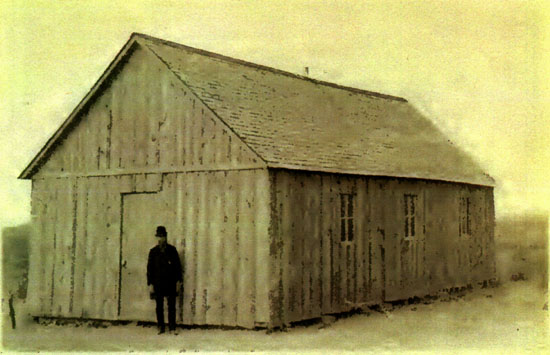
Congregational Tabernacle.
The Tabernacle was constructed in 1889 at the Southeast corner of Wolcott and present-day 1st Street. The building
was also used as a school house and town hall.
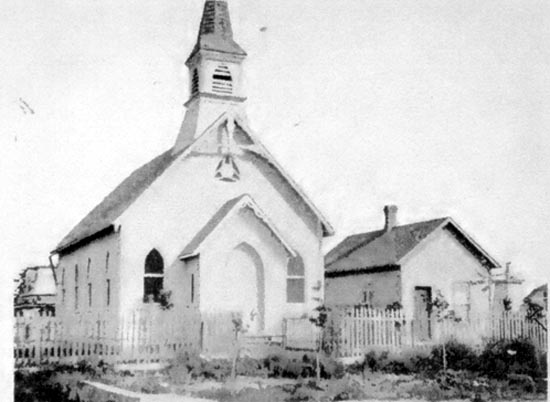
St. Mark's Episcopal Church, Casper, approx. 1900.
In 1890, Episcopal Bishop Ethelbert Talbot challenged the town to form
an Episcopal Church promising $500 of his own funds towards the construction of the new church. Additionally, he went from saloon to saloon raising funds. By 1891,
the new Episcopal St. Mark's Church was consructed at the corner of Wolcott and Second Streets. With the construction of
St. Mark's, in the words of Alfred James Mokler, History of Natrona County, 1888-1922, interest in the Tabernacle "waned and finally died."
The previous Congregational
Tabernacle was never consecrated. Therefore, St. Mark's became the first consecrated church in
Casper. Upon the construction of a new town hall the following year, the use of the
Tabernacle as a church was abandoned. The building was then
sold and used as a private residence.
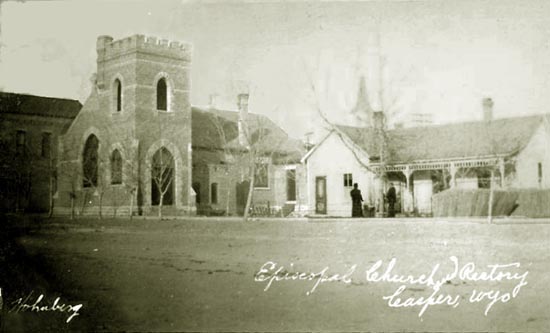
St. Mark's Episcopal Church and Rectory, approx. 1909.
At first the new church had no ordained rector. Therefore Bishop Talbot placed pastorial charge of the
church under Fordyce H. Argo, who had previously served as a lay reader in Idaho.
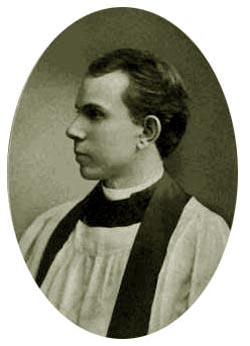 F. H. Argo F. H. Argo
The Reverend Argo was ordained several years later in Pennsylvania and served as the first rector of the Episcopal Memorial Church of the Holy Nativity in Rockledge, Pennsylvania.
The dedicatory sermon for the Holy Nativity Church was preached by Bishop Talbot. The Reverend Argo remained at Holy Nativity for over 50 years before
retiring to Florida in 1943.
The next priest for St. Mark's was the Reverend John Wilson from County Armagh, Ireland. The parish remained, however, as
poor as the proverbial church mice. Indeed, the parish did not become self supporting until after 1814. The Reverend and Mrs. Wilson received from both parishioners and non-parishioners alike donations of trout and sage chickens in the
summer to provide sustenance. In the winter antelope and deer were donated. Similar donations may not have been that
unusual. In one instance even though the Salvation Army had not yet colonized Casper, 200 lbs of rabbit were shipped to the
Salvation Army in Omaha to help feed the poor.
In 1907, the parish began construction of a new $8,000 brick church depicted above. The old wooden church was then moved further back on the
lot. The brick church remained in use until the present church was constructed in 1925 at the corner of 7th and Wolcott.
The next church to be organized in 1893 was the Methodist Episcopal Church located at the northeast corner of Durban and Second Streets. That was followed in 1898 by St.
Anthony's Roman Catholic Church located at the corner of First and Center Streets across from where the Henning Hotel was later located. In 1910, the
Baptist Church at Fifth and Beech was located, followed by the Presbyterians in 1913 at the corner of
Sixth and Durban.
In July 1916,, the Salvation Army set up at 142 West Second Street in a tent shipped in from Denver. In 1919, the Salvation Army began a
drive to raise $25,000 for the erection of a public service hut in Casper. It noted in its campaign that it had cast its
lots with the friendless, the homeless, the weak and the lowly, the "poor and the wretched of 61 countries." The Salvation Army is noted, of course,
for its enthusiastic songs, many of which originated in music halls but set to different words. "Storm the Forts of Darkness" was
derived from "Here's to Good Old Whiskey" and the most famous of all, "Stand Up for Jesus" was derived from
"Tis Dawn, the Lark is Singing."
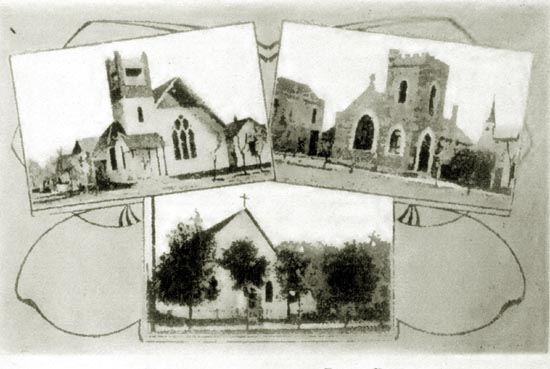
Top Left, Gantz Memorial Methodist Episcopal Church; Top Right, St. Mark's Episcopal Church
Bottom, St. Anthony's Roman Catholic Church.
The Catholic Church was located across Center Street from where the Hinning Hotel was later located.
Between 1890 and 1898, periodic Roman Catholic Masses were given by visiting priests. Some were given according to Mokler in the
town hall, private homes, and once in the Episcopal Church. The grown of an Irish population attracted to the wool industry made a permanent
building imparitive. Plans for construction of a church building commenced in 1897 and for a parish house about 1901.
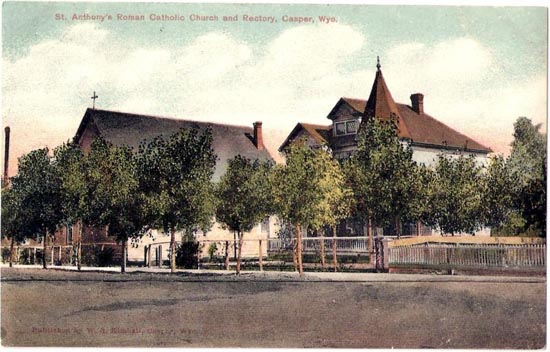
St. Anthony's Roman Catholic Church In 1916, the original site of the church was sold and in 1917 the original church building
was moved to the corner of Wolcott and Seventh.
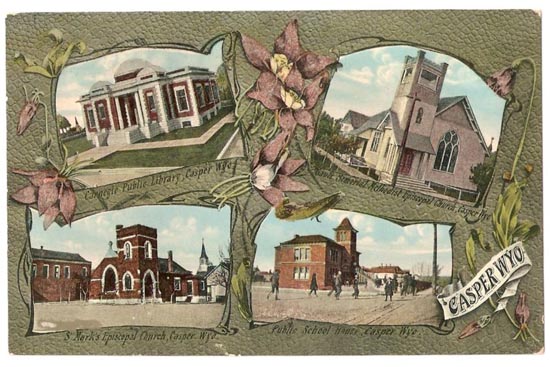
Top: Carnegie Library, Gantz Memorial Methodist Episcopal Church; Top Right,
Bottom: St. Mark's Episcopal Church, Public School.
The Carnegie Library was designed by Casper architect Charles A. Randall. Randall also designed the
Natrona County Courthouse, the Weston County Courthouse and buildings as far away as Deadwood.
The first library was housed in the Women's Christian Temperance Union clubhouse on Central. The Carnegie LIbrary was
at first projected to cost $10,000 with funds donated by Andrew Carnegie on the condition that the County
donate the site and $1,000 a year for its operation and maintenance. In 1909, in order to complete the structure and
provde for its furnishings, Mr. Carnegie donated an additional
$3,000, the County another $1,800 and Architect Randall his fee. In addition to housing the library, the basement
housed the Casper Cornet Band. The cement sidewalks in front of the library were installed in 1910.
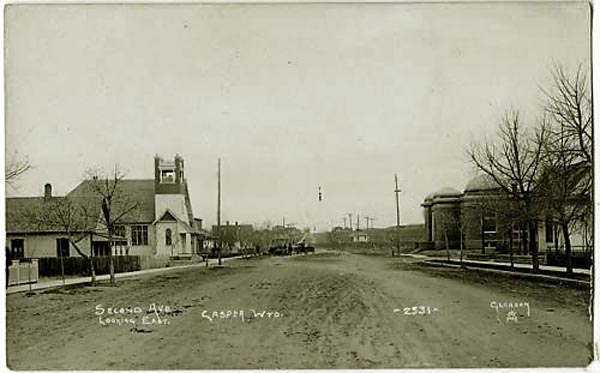
Second Avenue, Casper, looking east. Photo by O. S. Gleason, approx. 1912.
On the left is the Gantz Memorial Methodist Episcopal Church, On the right is the
Carnegie Library.
Next door to the library is the residence of A. J. Mokler.
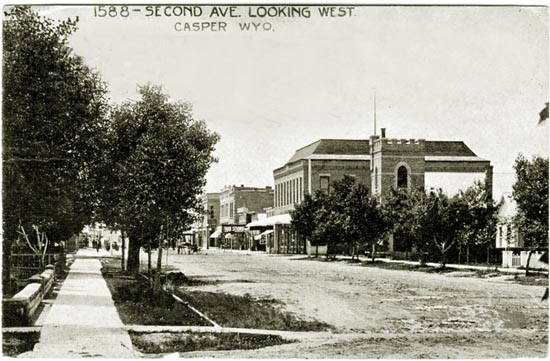
Second Avenue, Casper, looking west. approx. 1912.
On the right is St. Mark's Episcopal Church. Beyond the church is the Odd Fellows Hall.
Music this page:
When the Roll is Called Up Yonder, 1893
Music and Lyrics by James M. Black
When the trumpet of the Lord shall sound, and time shall be no more,
And the morning breaks, eternal, bright and fair;
When the saved of earth shall gather over on the other shore,
And the roll is called up yonder, I’ll be there.
Refrain:
When the roll is called up yonder,
When the roll is called up yonder,
When the roll is called up yonder,
When the roll is called up yonder, I’ll be there.
On that bright and cloudless morning when the dead in Christ shall rise,
And the glory of His resurrection share;
When His chosen ones shall gather to their home beyond the skies,
And the roll is called up yonder, I’ll be there.
Repeat Refrain
Let us labor for the Master from the dawn till setting sun,
Let us talk of all His wondrous love and care;
Then when all of life is over, and our work on earth is done,
And the roll is called up yonder, I’ll be there.
Repeat Refrain
"When the Roll is Called Up Yonder" was writen by a James M. Black (1856-1938), a Methodist
Sunday School Teacher in Williamsport, Pennsylvania. At first, the hymn was published anonomously with credit given only by his initials.
The song became so popular, that he was asked to set music to various published religious poems.
He persuaded a proverty striken young girl to attend
his Sunday school. She faithfully attended. One Sunday, she failed to respond when her name was called during roll call.
Concerned, he stopped by her home and found her dying of typhoid fever. With her death, she never again answered when her name was called in the Sunday school
meetings. Her absence so affected Mr. Black that he looked for a suitable hymn but was unable to find one in his hymnal. He later wrote:
An inner voice seemed to say, “Why don’t you write one?” I put away the thought.
As I opened the gate on my way home, the same thought came again so strongly that tears
filled my eyes. I entered the house and sat down at the piano. The words came to me
effortlessly. The tune came the same way—I dared not change a single note or word.
Next page, Casper Churches continued.
|